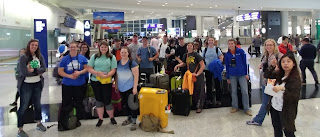May 14
Sunday, May 14
Continuing
our journey, when we arrived at our hotel last night and laid on our beds, we
found that people in Xi'an prefer a hard mattress. We would compare it to a piece of plywood
with a quarter inch of padding on top.
Surprisingly, everyone seemed to sleep well but are a little sore from
the bike ride yesterday. We had a full day planned with visits to a feed mill,
the NW Forestry & Agriculture University Beef Farm, a farm equipment
dealership, a local dairy and dairy production plant.
Our first
stop this morning was to a local feed mill located in the middle of the city of
Yangling. At the mill they produce feed
for pigs and chickens utilizing popcorn, whey powder, corn , peanut, fermented
soybean and fish meal. All of these are
sold in 50 kg bags, which is about 110 lbs.
The company has been open for 15 years, employs 15 workers.
The second
stop our group made was to Kingbull beef, also in Yangling. This company
produces high quality Japanese style beef. Kingbull Beef has 3 locations, with
10,000 head total. The genetic make-up of their brand of cattle is 25% Angus,
25% local, and 50% Waygu. This lineup is labeled Kingbull. Their beef is well
known for having No. 12 marbling, which is very desirable in the Chinese and
Japanese countries. This is commonly used in hot pot cooking. These cattle are
fed corn silage for 18 months, then are fed wheat straw up until 27-28 months.
The reason behind the wheat straw for 10 months is to increase the fat content
without increasing the amount of muscle. This is a perfect recipe for the
desired No. 12 marbling.
After
Kingbull Beef, we went to Northwest Forestry and Agriculture University for
lunch. This school has a nice campus with grass and trees all over the place.
The lunch was a buffet consisting of many different cultural Chinese foods.
The
machinery market was our next stop. All
of the equipment was significantly smaller and less expensive than what we
typically see in the US. The largest tractor they had, which was 50 horsepower,
cost 11,730 RMB, or $1700 US. The AST guys were pretty intrigued by all the
machinery we got to see!
To finish
off our day, we visited a dairy barn and processing/production facility. This
facility is located approximately 70 kilometers away from Xi'an. Once we
arrived to the processing facility, we were formally greeted by the Director of
Agriculture Bureau of the Shanxi province. He was delighted to have us touring
the building. This facility produces three different products: milk, powder,
and yogurt. The milk that is used in this processing facility comes from 20
different farms owned under this company.
The breeds
of cattle that this farm utilizes are New Zealand Holstein and Austrailian
Holstein with a few Jersey cows. Each cow that this company owns produces
approximately 41 lbs per day, which comes out to about 7000 kg per year. The
primary challenge that this farm faces is that the price of milk is very low.
This makes it hard to keep all employees paid properly. This facility is about
20 years old and employs 150 people. The requirements for their cattle are that
they are milked twice a day and fed three times a day. When the calves are
born, they are weaned about two weeks after. The plan for this company and
their dairies is to ultimately expand more when prices increase, and conduct
research projects to increase the knowledge of dairy production in China.
Corn storage
Kingbull
Milking parlor
Rice combine
Silage
Yogurt
Dusty, Grant, Andrew R.
Group photo at feed mill 5-14
Group photo at King bull
Group photo before lunch on campus
Group photo at dairy farm
King bull cattle farm
















Comments
Post a Comment